Papers by Peter A. Lutz

Lecture Notes in Computer Science, 2013
Supporting senior citizens with tools to recollect past experiences about everyday life is gainin... more Supporting senior citizens with tools to recollect past experiences about everyday life is gaining ground within HCI research. In this paper, we focus on how seniors reminiscing can be a resource for designers to uncover the situated aspects. In particular, we argue that an analytical focus on seniors’ memories is a fruitful stance for tracing how design practice situates issues of senior wellbeing. We employ the case of designing with senior citizens to design ICT for supporting adherence to physical therapy at home and discuss two retrospective examples. These examples highlight how seniors’ physical wellbeing was situated in, memories of a musically rich and mobile life, and memories of youthful male body. Through retrospection, we offer the preliminary notion of memoryscape as a conceptual term for orienting how a design process can mediate seniors’ memories as a way of accounting for situated elderliness in design.
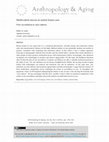
Anthropology & Aging, 2015
In this article I trace mediated effects that surface with attentions to seniors and their bodies... more In this article I trace mediated effects that surface with attentions to seniors and their bodies in care. This includes new technologies for visualizing and monitoring the body. I also consider the implications of mediated body-technology attentions for care surveillance. Surveillance offers valuable analytical purchase in the study of care. Yet, care attentions are not always straightforward. These can become obstructed, negotiated and transformed with technologies for care. There are multiple empirical examples of how technically mediated attentions produce ambiguous or multivalent effects, both in the literature and my own ethnographic work. These multivalent effects, I argue, displace the notion of surveillance in care. To strengthen my argument, I draw on STS-inspired anthropological studies of care. Lastly I proffer the term “care-valence” as a heuristic compliment to the notion of care surveillance. This term, I proffer, benefits the analysis of how care attentions effect so...
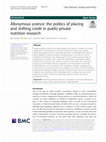
Life Sciences, Society and Policy, 2020
Ideally, guidelines reflect an accepted position with respect to matters of concern, ranging from... more Ideally, guidelines reflect an accepted position with respect to matters of concern, ranging from clinical practices to researcher behaviour. Upon close reading, authorship guidelines reserve authorship attribution to individuals fully or almost fully embedded in particular studies, including design or execution as well as significant involvement in the writing process. These requirements prescribe an organisation of scientific work in which this embedding is specifically enabled. Drawing from interviews with nutrition scientists at universities and in the food industry, we demonstrate that the organisation of research labour can deviate significantly from such prescriptions. The organisation of labour, regardless of its content, then, has consequences for who qualifies as an author. The fact that fewer food industry employees qualify is actively used by the food industry to manage the credibility and ownership of their knowledge claims as allonymous science: the attribution of science assisted by authorship guidelines blind to all but one organisational frame.
Lecture Notes in Computer Science, 2013
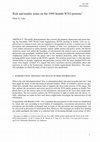
In M. P. Cottam, D. W. Harvey, R. P. Pape, & J. Tait (Eds.), Foresight and Precaution (pp.35-42). , 2000
The public demonstrations that evolved into property destruction and unrest dur- ing the December... more The public demonstrations that evolved into property destruction and unrest dur- ing the December 1999 World Trade Organization (WTO) meeting in Seattle, USA are ex- plored here in relation to how risks are regarded or disregarded in society; a central issue in risk perception and communication research. A number of risks were positioned in this dramatic event seldom discussed as safety hazards, namely public protest and police action, but skirted numerous issues well within the boundary of conventional risk analysis such as environmental destruction and genetically modified foods. As this meeting proceeded the mainstream media emphasized clashes between the police and a few hundred anarchists, rather than the more pressing global issues found on the WTO’s agenda. The problem posed here is why did main- stream media so strongly emphasize this particular concern while the more standard WTO risk issues were largely avoided? It is argued that such a problem concerns journalistic ethics and practices, as well as the bureaucratic structures of media organizations themselves. The scien- tific paradigm on which the study of risk is based is also questioned.

Practising Comparison: Logics, Relations, Collaborations (forthcoming, 2016) Edited by Joe Deville, Michael Guggenheim and Zuzana Hrdličková, 2016
This chapter stems from my ethnographic study of senior home care in the United States (US) and S... more This chapter stems from my ethnographic study of senior home care in the United States (US) and Sweden. In this study, I trace relations between people and technology as they come together in gatherings or ‘collectives’ (Moreira 2010) for care. Specifically, I am interested in how care moves with these collectives and generates interrelated consequences for the human and nonhuman actors concerned. However, these relational moves of care are rarely smooth. Instead, they comprise ongoing tensions or ‘frictions’ (Tsing 2005) which situate multiple acts of negotiation and ‘tinkering’ (Mol 2008; Mol et al. 2010). As such, ‘care moves’ offers a conceptual-empirical figure for fine-tuning ethnographic attention to care as a rough and tinkered process. It denotes an analytical emphasis on care as a mediating phenomenon interwoven with collective relations on the move, empirically and conceptually — entailing both effects and affects.
TIME AND THE FIELD Edited by Steffen Dalsgaard and Morten Nielsen Afterword by George Marcus, 2015
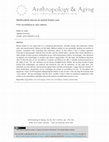
Recent studies of care argue that it is a relational phenomenon, whereby human and nonhuman enti... more Recent studies of care argue that it is a relational phenomenon, whereby human and nonhuman entities enter into transformative relations. In this light, different entities of care potentially mediate one another in practice, sometimes with surprising and unforeseen effects. In this article, I trace a similar argument. Drawing on ethnographic material from Sweden and the United States, I proffer that careful attentions to older people at home produce multivalent moves with transformative effects. Increasingly, such attentions encompass new technologies to monitor and observe aging bodies. On this topic, the healthcare literature often invokes the idea of care surveillance. Certainly, surveillance can offer a valuable analytical purchase in the study of care. Yet, care attentions are not always straightforward. Rather, the moving around of aging bodies with technologies can obstruct and transform care and its attentions. At the same time, care attentions can also obstruct and transform aging bodies and their technologies. I argue that the existence of these multivalent, somatechnic moves challenges the notion of surveillance in care. To strengthen this argument, I draw on STS-inspired anthropological studies of care. In turn, I also develop the heuristic term “care-valence”. The key advantage with this term, I proffer, is that it offers an analytical compliment to the notion of care surveillance and helps refocus the analysis on multivalent moves in care.

Like many countries, Sweden faces the challenge of popu-lation aging and senior care. Compared wi... more Like many countries, Sweden faces the challenge of popu-lation aging and senior care. Compared with institutionalized health care, senior home care offers a viable option, promising familiar sur-roundings and lower costs. However, those performing senior home care sometimes resist time-management policies that pressure such care in practice. Some scholars analyze this situation as opposition between ‘objective’ and ‘subjective’ time. This article takes a different route. It explores how time surfaces in Swedish senior home care through relational movements of care. These enlist things such as schedules, machines, and aging bodies. To this end, the article also experiments with ‘surfacing’ as an ethnographic heuristic for figuring these different ‘spatial-timings’. The article concludes that surfacing matters not only in senior home care but also in the field-desks of ethnographic analysis.
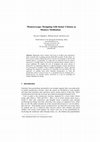
Lecture Notes in Computer Science, 2013
Supporting senior citizens with tools to recollect past experiences about everyday life is gainin... more Supporting senior citizens with tools to recollect past experiences about everyday life is gaining ground within HCI research. In this paper, we focus on how seniors reminiscing can be a resource for designers to uncover the situated aspects. In particular, we argue that an analytical focus on seniors' memories is a fruitful stance for tracing how design practice situates issues of senior wellbeing. We employ the case of designing with senior citizens to design ICT for supporting adherence to physical therapy at home and discuss two retrospective examples. These examples highlight how seniors' physical wellbeing was situated in, memories of a musically rich and mobile life, and memories of youthful male body. Through retrospection, we offer the preliminary notion of memoryscape as a conceptual term for orienting how a design process can mediate seniors' memories as a way of accounting for situated elderliness in design.
STS Encounters (4:2), 2011
DASTS er en faglig forening for STS i Danmark med det formål at stimulere kvaliteten, bredden og ... more DASTS er en faglig forening for STS i Danmark med det formål at stimulere kvaliteten, bredden og samarbejdet inden for dansk STS-forskning samt at markere dansk STS tydeligere i nationale og inter-nationale sammenhaenge. This special issue is a follow up on a PhD course entitled "Framing Screens: Knowledge, Interaction and Practice" held at the IT Univer-sity of Copenhagen in the fall of 2010. Course participants from a variety of disciplines and countries joined the senior faculty who served as midwives for the births of new understandings and con-ceptualizations of screens.
Editorials and Book Reviews by Peter A. Lutz
dasts.dk
DASTS er en faglig forening for STS i Danmark med det formål at stimulere kvaliteten, bredden og ... more DASTS er en faglig forening for STS i Danmark med det formål at stimulere kvaliteten, bredden og samarbejdet inden for dansk STS-forskning samt at markere dansk STS tydeligere i nationale og inter-nationale sammenhaenge. This special issue is a follow up on a PhD course entitled "Framing Screens: Knowledge, Interaction and Practice" held at the IT Univer-sity of Copenhagen in the fall of 2010. Course participants from a variety of disciplines and countries joined the senior faculty who served as midwives for the births of new understandings and con-ceptualizations of screens.


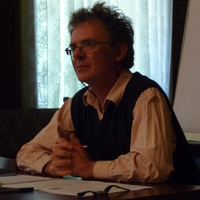







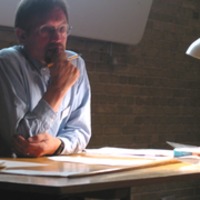
Uploads
Papers by Peter A. Lutz
Editorials and Book Reviews by Peter A. Lutz